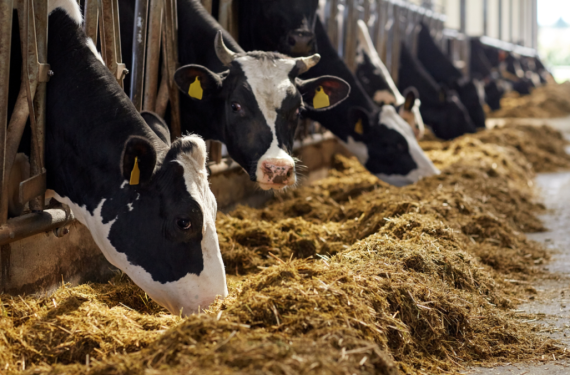A new feed additive developed by DSM inhibits the emission of the greenhouse gas methane by cows, like adding nitrate to the feed does. Animal feed researcher Jan Dijkstra outlines the effect and possibilities.
‘The effectiveness of Bovaer – DSM’s product that inhibits methane synthesis – will soon be tested at the Dairy Campus, the research and innovation centre for the dairy farming at Wageningen Livestock Research’, Dijkstra says.
‘This testing is necessary to include the product in the Kringloopwijzer (“Circularity Guide”), the tool dairy farmers use for mineral management. The guide estimates the volume of greenhouse gases the cows produce based on the amount of feed concentrates, grass and silage maize content used in their rations. WUR researchers are currently testing how much methane emissions drop for various feed rations. Farmers can then use those figures when using the Kringloopwijzer.’
What will this research yield?
‘When using Bovaer with the Dutch ration, methane emissions are expected to drop by around 20 percent. This is less than the 30 percent DSM claims based on international research. That is because Dutch rations contain a lot of fibre. The product becomes less effective with more fibre. Bovaer might become available by the end of next year. It is currently being assessed by the European Food Safety Authority, EFSA.’
Would adding nitrate help as well?
‘When nitrate is added to the feed, bacteria convert nitrate into ammonia, resulting in less methane. This process was investigated at WUR’s experimental farm De Marke. This takes a different approach to Bovaer. Bovaer is a molecule that binds to an enzyme that forms methane in the rumen of the cow; it stops the enzyme’s activity. Only 0.06 grams per kilogramme of feed is required. But nitrate is needed in much higher amounts. To achieve a methane reduction of 10 to 15 percent, 10 to 15 grams of nitrate per kilogramme of feed is needed.’
Could Bovaer be combined with nitrate?
‘We do not yet know whether the effects of Bovaer and nitrate stack, thus achieving a 30-35 percent reduction in methane emissions, or whether there are interactions between the two substances. In any case, the two can aid in achieving a substantial decrease. Nitrate is naturally contained in grass silage, but the pure additive is supplied by the agro company Cargill. Cargill is also researching this methane inhibitor for the Kringloopwijzer.’
Will this be sufficient to achieve the climate goals?
‘Livestock farms are required to cut methane emissions by half in the coming years. These additives will allow farmers to make good progress in that direction. But it takes money, so the milk price will have to increase somewhat.’

 Photo: Shutterstock
Photo: Shutterstock